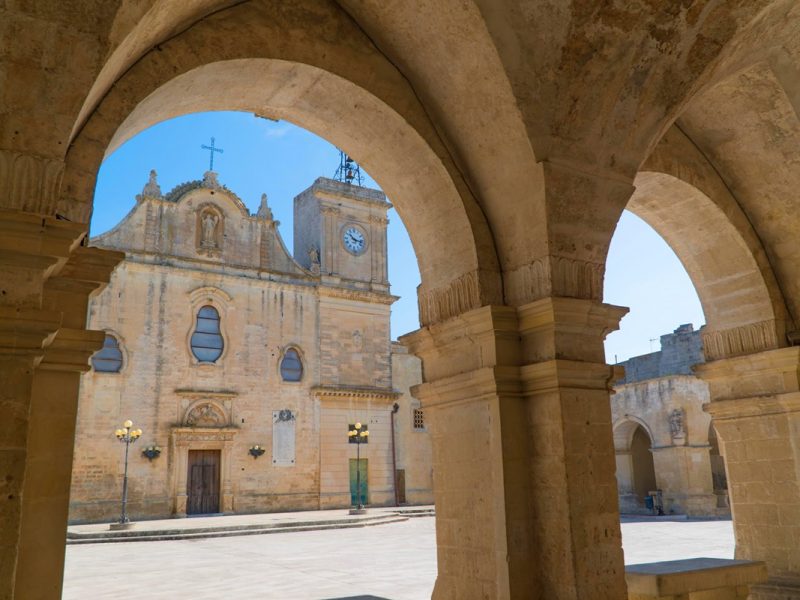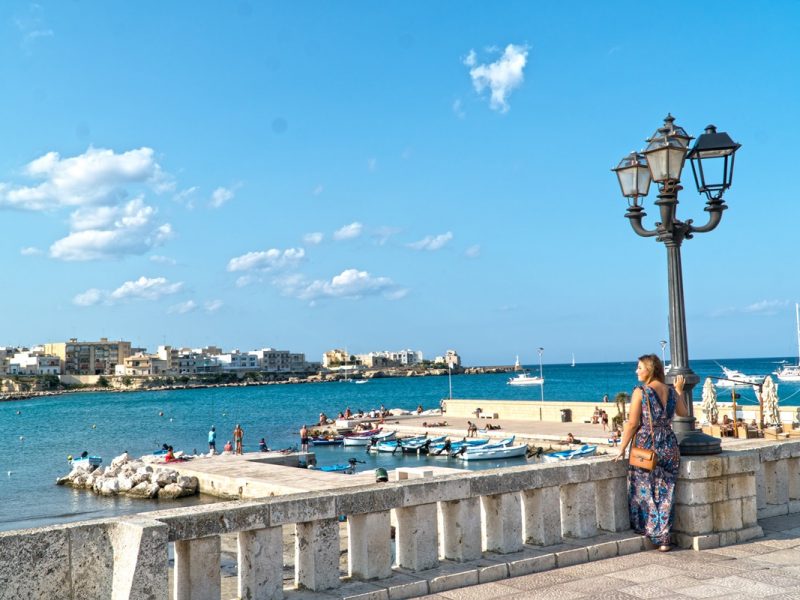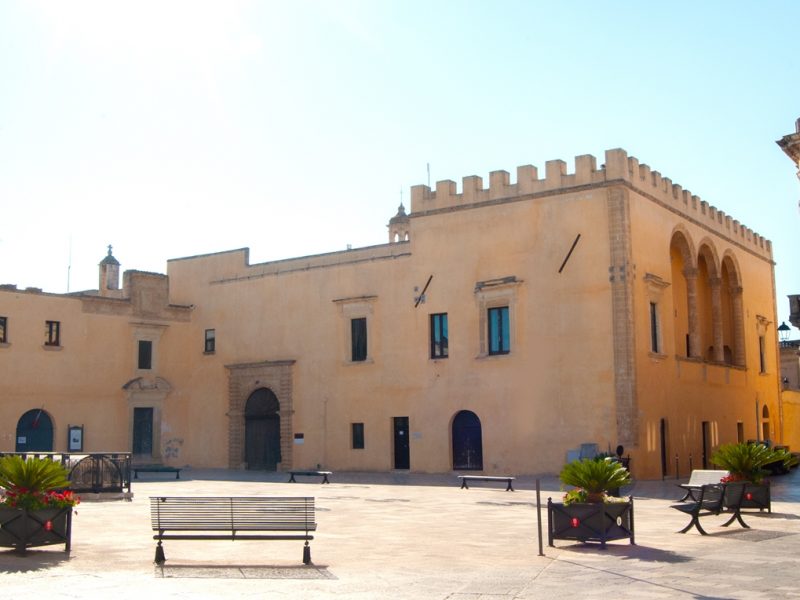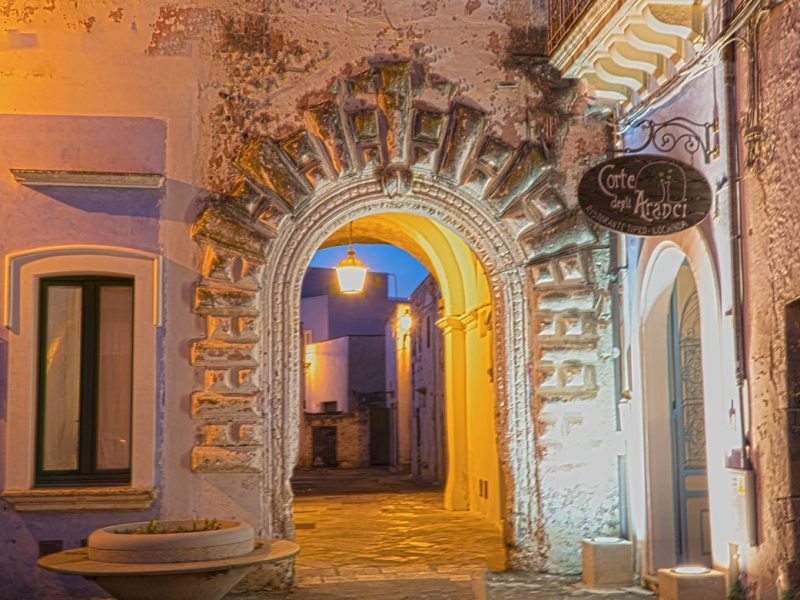The Borgo of Gallipoli
You cannot leave Salento without visiting Gallipoli, simply because the emotions and sensations of this magical place is an experience not to be missed.
In summer, watching the sunset while floating in the silky, emerald green sea of Baia Verde (Green Bay) is near the top of the list of “The 10 Things to Do in Salento”, and afterwards, with the mineral-rich sea salt still on your skin, trusty backpack on your shoulders, finish the evening by adventuring through the enchanted streets of the old city, “Gallipoli vecchia”, among the markets and fish restaurants, exploring a corner of the world that is literally thousands of years old.
Gallipoli is “la città bella”, the beautiful city, and it is always beautiful, whether the strong “tramontana” wind is blowing, or the ancient stone streets are glistening in the falling rain, or the sun is shining and sparkling over the waves of the sea. Built on an island, the old city, “Gallipoli vecchia”, still preserves the Greek features of her origins, while boisterously demonstrating her “Salentina” identity. Churches of Carparo stone and palaces from the 1700’s wind their way along the ancient Byzantine walls, creating a labyrinth that was designed to confuse invading enemies and still captures and bewitches visitors today.
History
When the Greeks first landed on this island touching the coast of the Ionian sea, there was only one name they could give their new colony, Kallìpolis, beautiful city. Over the centuries, the Greek origins of Gallipoli left their mark on future populations. It was conquered by Rome and remained under its dominion until 265 AD, when reached its darkest hour after being sacked by barbarians…to be later reborn with a Byzantine soul.
Gallipoli has been subject to various dominations, from the Angevins (Plantagenets) to the Normans, and then the Spanish ruling family of the Bourbons, who initiated a period of vigorous expansion to crafts, navigation, as well as a busy trade in lamp oil.
When Gallipoli became part of the Kingdom of Naples, its Spanish ruler, Francesco I of the Bourbons, constructed what is known today as “il porto vecchio”, the old port. Thanks to this investment in navigation, the prestigious oil of Salento illuminated courts and salons around the world, giving it the reputation of a rich and powerful city. This fame lasted well beyond the Unification of Italy in 1861, when, together with Lecce and Otranto, it was one of the three district capitals.
Today, it is one of the most famous “borghi” in Italy, a favorite summer destination for tourists, who fill the white sand beaches and crowd the ancient streets and chic nightclubs, but Gallipoli is much more: it is a Venus rising from the Ionian Sea, glowing with a transcendental beauty in every season.
Il Castello Angioino, the Angevin Castle
The Angoino Castle of Gallipoli is an island on an island, almost entirely surrounded by the sea, from where you can admire the bridge connecting the new city to the old .
The original architectural structure was built in the Angevin period in the form of a square, to be later remodeled by the Aragons, who rounded the edges and constructed watch towers, which for centuries protected the population from foreign attack.
Recently, the Castle has been opened to the public, revealing treasures that not even the local population were aware they had. From the interior you can see the original entrance with its drawbridge, which was hidden by the construction of the covered marketplace. The enormous salt warehouse gives testimony the grandiose commerce of Gallipoli’s past; the spacious noble salons recount the ostentatious splendor of court life, as does the chapel that was once covered in an enormous fresco, in fact, every where you look you find traces of the inhabitants that once lived here and made this castle great.
Fontana Greca, the Greek Fountain
The Greek Fountain of Gallipoli was long famed to be the most ancient in Italy. This has recently been challenged by various scholars, who attribute it to the Renaissance period, triggering a historical controversy as yet to be resolved.
The four carytids (pillars in the form of female sculptures) recount the metamorphosis of Dirce, Salmacis, and Biblis: stories of love and revenge, divinities and mortals, in fact, still today it is considered “The Fountain of Scandal”.
Dirce had a young servant under her protection, who gave birth to twins. When Dirce’s husband ordered her to abandon them, she obeyed, but the twins, raised by a shepherd, returned to avenge their mother. They tied husband and wife to two bulls to have them dismembered, except that at the last minute, Dionysus took pity on Dirce and transformed her into a fountain.
Salmacis, a naiad, or fountain nymph, fell in love with Hermaphrodite, and as she embraced him she asked the gods to always remain bonded with him. The gods, in an attempt to satisfy her request, joined their two bodies together, causing the furious Hermaphrodite to curse the fountain and anyone who came to draw water from its source.
According to mythology, the naiad Biblis fell in love with her own brother Caunus, who fled from home to avoid committing incest. Biblis searched for him desperately until she was exhausted with grief and near death, when the gods took pity on her and turned her into a fountain as well.
In times gone by, water bearers drew water from the mouth of this fountain to refresh the city; today, its extraordinary beauty can also be admired in a series of collectable stamps dedicated to the fountains of Italy.
Cattedrale di Sant’Agata, the Cathedral of Saint Agatha
Entering the old city, a little further past the Angioino Castle, we find the Cathedral of Sant’Agata, Saint Agatha. This important place of worship was built on the highest point of the city and there it reigns, majestic and imposing, a truly striking monument. In this church, the excellence of pale and durable Carparo stone from Gallipoli takes precedence over the classic, golden “Leccese” stone, with the ornate Baroque style adorning the façade nonetheless.
The interior of the Cathedral is a treasure trove of important works, including paintings by local artists as well as the Neopolitan master, Nicolo Malinconico. The carved wooden choir platform is of magnificent craftsmanship and the elegant form of the sculpted marble altar is opulent and lavish, exalted by its multicolored hues. The entire Cathedral is sumptuous and refined, thanks to the fine workmanship in Carparo stone, and it conserves numerous relics of saints. The most important relic it held, however, was the breast of St. Agatha (cut off by a Roman official when she refused to renounce her faith and accept his advances), which was moved to the Cathedral of Santa Caterina D’Alessandria in Galatina, upon the construction of that church.
La chiesa di Santa Maria della Purità, the Church of St Mary of Purity
The church of Santa Maria della Purità faces a beautiful curving beach, “La Spiaggia della Purità”, the beach of purity. Today an irresistible seaside destination, it was once the main port where Gallipoli’s ships set sail, carrying oil, wheat, and livestock in their wooden hulls.
The façade of the church is simple and white-washed, with discrete Carparo stone decorations framing paintings of Santa Maria della Purità, San Giuseppe, and St. Francis of Assisi. The interior, however, greets you with an explosion of color: the walls are entirely covered by paintings in golden frames, telling the stories of the Old and New Testament, with the columns and cornices inlaid with floral motifs.
The central canvas depicts the multiplication of loaves and fishes, and during its restoration four wooden stele were discovered under the painting, portraying the four evangelists. In order to allow visitors to enjoy both masterpieces, a revolving mechanism was constructed, creating an unexpected special effect.
This church is a symbol of social vindication on the part of the lower classes of the population. The fraternity of dockworkers who constructed this church invested all their faith and dedication, sparing no effort to grace it with taste and refinement, proudly demonstrating they had no reason to envy the churches built by the wealthier factions of society.
The fraternity of the Purità was ahead of its time, offering assistance to the community in the form of social services. Joining the fraternity was obligatory for the dockworkers, who then paid in a small part of their earnings each month. In exchange, they received sick pay when were ill, and financial support was provided to their widows and children after their death.
The Historical Center
The historical center, “Gallipoli vecchia”, the old city, is constructed on a little island almost touching the coast. It is built in a ring of walls facing the sea, but once inside the protected stone streets, you enter a wonderland.
A network of winding lanes and cobbled streets invite you to discover poetic angles and vignettes outside of time; imposing palaces and sculpted baroque balconies, teasing glimpses of arched stone courtyards carved in the local Carparo stone, all combine to give the borgo an aura of refinement and unique charm.
Returning to the riviera along the sea wall, we find a series of little churches, each one a unique jewel in its own right, such as the church of San Francesco da Paola, with its simple façade and dazzling interior, glowing with golden decorations and paintings that captivate and enchant your gaze. Along the stone streets, we find the “casa a corte”, the courtyard communities, ancient structures built as homes for the simple lives of olive oil producers and fishermen. The most wonderful of these is surely “Corte San Gallo”, a courtyard full of traditional objects, draped with climbing vines and every kind of fishing net imaginable, which once held the water-bearers cart and a shrine to San Giuseppe.
It is the golden hour of sunset, and from the sea walls we see the ships returning to port. The traditional wooden fishing boats, with their wide hulls and bright, cheerful colors, dock at the old port and the people waiting on shore crowd around to greet them…they are loaded with freshly caught fish, the true gold of Gallipoli.
The Light of Gallipoli: lamp oil and the subterranean olive mills
In the past, Gallipoli illuminated Europe, with its beauty, and above all with its high quality lamp oil. The thirty subterranean olive mills, the “frantoi ipogei”, dug in underground caves throughout the old city, produced a prestigious oil that lit the sleepless nights of Voltaire and the Russian Empress Catherine the Great. The olive oil producers of Gallipoli produced more oil than the cities of Brindisi and Taranto combined, but it was a hard life for the manual laborers, never older than 25 years old, who went underground in October or November and didn’t come back to the surface until May. The sole exception was on Good Friday, when they were allowed to come out for the procession. The person in charge of the “ipogei” was a type of foreman, called “il Nachiro”, who was chosen at the beginning of the season from among the workers. In Ancient Greece, the “Nachiro” was the person in charge of decision making in commercial shipping activity; in subterranean olive mills of Salento, it was the role given to the wisest and most diplomatic of the group, who was responsible for managing the workers and supervising the collection of the olive oil at the end of the work cycle.
Working as a “frantoiano”, an olive mill worker, was a great honor, something that was done only once in a lifetime, and which generated earnings that were enough to guarantee a secure future. However, the subterranean olive mills were dug out of Carparo stone, and Carparo is porous, letting water filter in, which created a cold, damp environment that often led to illness and sometimes even death.
Today, the “frantoi ipogei” of Gallipoli have been restored and can be visited in guided tours that explain everything from the “Nachiri” and the “oiu niuru” (black oil), to the tombs and fascinating “tumuli”, ancient, arched stone burial constructions. Every summer, tens of thousands of visitors come to discover the art and history of Gallipoli , with public interest increasing every year, proof that Gallipoli is appreciated for more than just beaches, concerts, and nightlife.
“Il malladrone” The Unrepentant Thief of ‘horrid beauty’
Legend, old wives-tales, and a dash of poetry: these are the ingredients of a fascinating and evocative story, “il malladrone”, the Unrepentant Thief of Gallipoli.
Of all the churches scattered throughout the historical center of Galipolli, three are said to be sister churches, as they all stand near each other along the sea wall road of Nazario Sauro. They have always been there, looking out to sea, sending their protection to the sailors who brave its waters every day. The most ancient of the three churches is dedicated to St. Francis of Assisi, and it is said that St. Francis himself commissioned it.
The people of Gallipoli hold this church especially dear, not only because of its extraordinary beauty, but also because its walls enclose a strange scenario featuring “il malladrone”, the Unrepentant Thief, who was crucified next to Christ.
In 1680, the church of San Francesco d’Assisi passed into the hands of the Baroness Capece, and in this period the custodian of the castle of Gallipoli brought some new additions to the church, a statue of Christ on the Cross, and also the two thieves who were crucified with him, also on crosses. They are the repentant thief, Disma, and the unrepentant Misma, who, with obstinate stubbornness refuses to listen to Jesus, even at the moment of his death, and who even today represents the Devil.
The thieves of Gallipoli are carved in wood and dressed in real clothing. It is said that Misma’s sins were so terrible as to rip apart his soul, and with it, the clothing on his effigy, explaining the mystery of why his garments were constantly torn and had to substituted so often.
The grimacing features of the Unrepentant Thief are so terrifying that for years it was believed his teeth were real, taken from a man condemned to death. Only recently has it been established that they are actually carved in wood.
Long ago, the fame of the Unrepentant Thief even reached the illustrious writer and public figure Gabriele d’Annunzio, who wanted to see Misma and his torn clothing for himself, but only at night,
and only by candlelight. He was so struck by the experience that he described him as having a “horrid beauty”.
The church of San Francesco d’Assisi was closed for a decade, and only re-opened for worship in 2005, after restoration work. During the restoration it was discovered that the wall where the Unrepentant Thief was hanging was the wall most exposed to the sea, wind, and salt air, which infiltrated the wall and corroded Misma’s clothing. We’ll pretend not to know this however, and continue to be fascinated by this incredible story.
Gian Domenico Catalano
Very little is known about the life of this Salento painter, but from his paintings we know that he worked primarily between the years 1550 and 1600. ***His works reflect the influence of the Venetian school of the 1600’s, and in fact it was in Venice that he completed his artistic training.***
The sacred art of his paintings can be found in numerous churches around Salento: in Gallipoli his works grace the Church of del Carmine, the Church of San Domenico, the Church of San Francesco and also the Church of Sant’Agata. More of his paintings can be found in Lecce, Alezio, and Presicce.
The date of his death remains uncertain.
Scapece
Salento cuisine is simple and basic, based on high quality olive oil and the fruits of the earth: legumes, vegetables, and of course, the fresh homemade pasta made with durum wheat (“grano duro”). The cuisine of Gallipoli, however, is vastly different from the traditional country fare that has become Salento’s trademark. As it is a seaport, you can always find an abundance of fish on the menu, offered in a wide range of delicious dishes based on fresh fish and seafood.
Even today, a multitude of fisherman head out to sea with the dawn and return at sunset, their wooden boats loaded up with another day’s fresh catch.
One emblem of traditional Gallipoli cuisine is “Scapace”, a traditional fisherman’s dish, which today has become a veritable institution during holidays and celebrations, and on the menus of the local restaurants.
“Scapece” is based on a few simple ingredients:
– “pupiddri”, small fish
– saffron
– flour
– bread crumbs
– white wine vinegar
– extra-vergine olive oil
“Scapece” is fairly simple to prepare. The first step is a visit to the fish market to buy the “pupiddri”, small fish. Next, roll the fish in flour and immerse them in boiling olive oil until golden brown.
Meanwhile, splash the vinegar onto the breadcrumbs and saffron, mixing to form a soft yellow paste, which is then spread onto the serving plate. Once fried to perfection, the fish are positioned, layer after layer, on the golden bed of breadcrumbs and saffron, and your traditional dish is ready to be served!
In ancient times, the layers of fish were preserved in wooden barrels; today, the dish is served on ceramic plates, because… details may change, tradition remains.

 Italiano
Italiano
 Deutsch
Deutsch
























